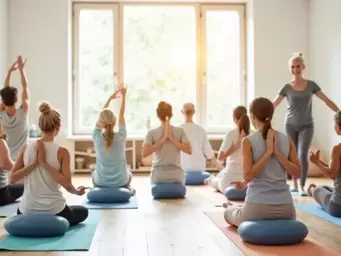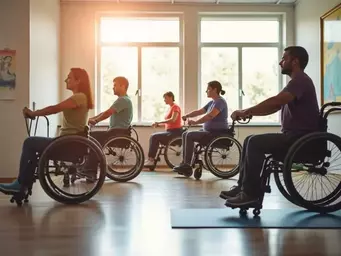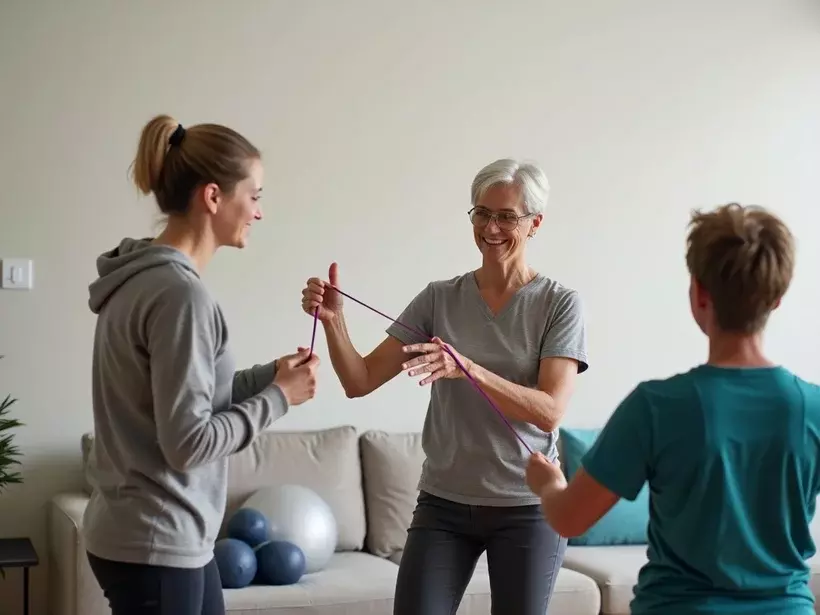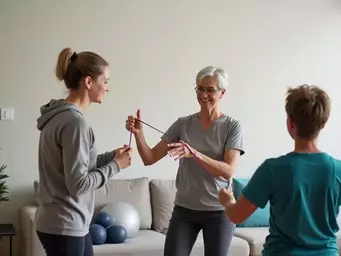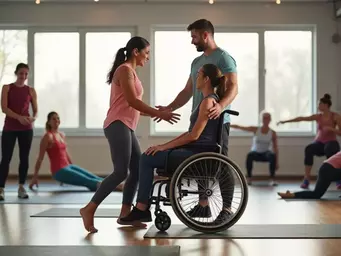Building Movement Programs for Disabilities

What if the simple act of moving your body could transform lives? Embracing movement is not merely about fitness; it’s an invitation to independence and joy, especially for individuals with disabilities. Let's explore the essential takeaways about creating inclusive movement programs that empower everyone to thrive.
What You Will Learn
- Importance of Movement: Tailored movement programs significantly enhance physical, cognitive, and emotional well-being for individuals with disabilities.
- Key Principles of Inclusion: Accessibility, engagement, individualization, and support are critical for creating inclusive movement programs.
- Understanding Disability Rights: The ADA ensures individuals with disabilities have equal opportunities and access to movement activities.
- Assessment is Key: Properly assessing individual needs allows for the development of personalized and effective movement programs.
- SMART Goals: Setting specific, measurable, achievable, relevant, and time-bound goals guides the success of movement initiatives.
- Adaptation Strategies: Implementing assistive devices and modifying movements helps ensure inclusivity in activities.
- Engaging Participants: Involving participants and caregivers in program development fosters ownership and relevance of movement activities.
- Measuring Success: Evaluating program outcomes through participant feedback and physical assessments helps refine and improve programs.
- Promotional Strategies: Community events, social media campaigns, and partnerships are vital for increasing awareness and participation in inclusive programs.
Key Benefits of Adapted Physical Activity
Adapted physical activity significantly enhances individual well-being through various avenues. Here are some of the core benefits illustrated below:
Enhance Physical Health
Regular movement improves strength, flexibility, and overall fitness.
Boost Cognitive Function
Physical activity promotes brain health and cognitive development.
Support Emotional Well-Being
Movement helps reduce anxiety and depression, contributing to a happier state of mind.
Foster Community Engagement
Inclusive programs create a sense of belonging and community for participants.
Embracing Movement: Crafting Inclusive Programs for Disabilities
At Health Moves, we believe that everyone deserves the chance to experience the benefits of movement. Tailored movement programs can significantly enhance the physical, cognitive, and emotional well-being of individuals with disabilities. Movement isn’t just about exercise; it’s a pathway to independence, joy, and personal growth! Whether it’s a gentle stretch or a lively dance, finding the right activities can truly transform lives.
Understanding the Need for Adapted Physical Activity
Why are movement programs essential? Let's break it down! Engaging in physical activity can:
- Enhance Physical Health: Regular movement can improve strength, flexibility, and overall fitness.
- Boost Cognitive Function: Physical activity promotes brain health and cognitive development.
- Support Emotional Well-being: Movement can reduce anxiety and depression, contributing to a happier state of mind.
By adapting these programs to fit individual needs, we open doors to opportunities that foster a sense of belonging and community. It’s about creating inclusive spaces where everyone feels empowered to participate.
Essential Principles of Disability Inclusion in Movement Programs
Creating inclusive movement programs isn’t just a goal; it’s a necessity! Here are some key principles that guide our approach:
- Accessibility: Ensure that activities are designed to accommodate varying abilities.
- Engagement: Programs should be fun and enjoyable, encouraging full participation.
- Individualization: Tailor activities to meet the unique needs of each participant.
- Support: Provide additional assistance, such as caregivers or equipment, to foster inclusion.
These principles help ensure that everyone can participate and feel valued, making movement a joyful experience. It’s about building a community where everyone belongs!
Disability Rights and the ADA
Understanding the significance of disability rights is crucial in shaping inclusive movement practices. The Americans with Disabilities Act (ADA) promotes equal opportunities for individuals with disabilities. Its importance lies in:
- Legal Protection: The ADA provides protections against discrimination in various areas, including physical activity.
- Access to Services: It mandates that facilities must be accessible to all individuals.
- Awareness and Advocacy: Encourages communities to become more aware of the needs of individuals with disabilities.
At Health Moves, we advocate for adherence to the ADA principles, ensuring that all movement programs we create comply with these valuable standards. By doing so, we help foster an environment of inclusivity and empowerment.
Step-by-Step Framework for Developing a Movement Program
Assessing Individual Needs and Abilities
Before setting up a movement program, we need to understand the unique needs of each participant. This process involves:
- Physical Assessments: Evaluating current fitness levels and mobility.
- Sensory Considerations: Understanding any sensory sensitivities that may affect participation. For additional guidance on making activities inclusive, this disability adaptation guide offers valuable insights.
- Communication Needs: Identifying how participants prefer to communicate and interact.
This comprehensive assessment allows us to design programs that fit perfectly, ensuring everyone enjoys the benefits of movement!
Establishing Clear Objectives and Goals
Setting clear objectives is essential to guide our movement program. Here’s how to establish effective goals:
- SMART Goals: Make sure goals are Specific, Measurable, Achievable, Relevant, and Time-bound.
- Individual Focus: Base goals on each participant’s unique abilities and interests.
- Overall Health Promotion: Aim to enhance both physical fitness and overall well-being.
By focusing on these principles, we can create a roadmap for success, helping participants achieve their desired outcomes!
Integrating Occupational and Physical Therapy Principles
Incorporating insights from occupational and physical therapy is invaluable. Here’s how these disciplines can enhance our movement programs:
- Holistic Approach: Address both physical and functional needs through tailored exercises.
- Skill Development: Focus on enhancing daily living skills alongside physical fitness.
- Therapeutic Techniques: Use therapeutic methods to promote safety and well-being during activities.
This integrated approach not only enriches our programs but also supports participants in achieving their personal goals and improving their quality of life.
Selecting Appropriate Activities for Diverse Abilities
When it comes to selecting activities, variety is key! Here are some adaptable options to consider:
- Seated Stretches: Perfect for individuals with limited mobility.
- Wheelchair Exercises: Inclusive activities that promote fitness while seated.
- Group Classes: Fun social interactions that foster community while engaging in movement.
By offering diverse activities, we can meet the varied interests of participants and ensure everyone can join in on the fun!
Implementing Adaptation Strategies for Inclusivity
Adaptation is essential for ensuring inclusivity in movement programs. Here are some techniques to consider:
- Assistive Devices: Use of mobility aids, adaptive equipment, or technology to facilitate participation.
- Modified Movements: Adjust exercises to suit differing abilities and strengths.
- Environmental Adjustments: Altering the space to accommodate all participants effectively. For guidance on making events accessible, refer to this planning guide for accessible events.
By implementing these strategies, we create a welcoming environment where everyone can thrive and enjoy movement!
Engaging Participants in the Development Process
Finally, involving participants and caregivers in the development of movement programs is crucial. Here’s how to make this happen:
- Feedback Sessions: Regularly gather input from participants about their preferences and experiences.
- Co-creation Workshops: Engage participants in designing the program, fostering ownership and pride.
- Open Communication: Maintain ongoing dialogue with participants to ensure their needs are met.
By making participants a part of the process, we can develop programs that truly resonate with their experiences and aspirations. Together, we can create something wonderful!
Engage with Us!
What challenges have you encountered in promoting inclusive movement programs? We’d love to hear your thoughts and experiences! Share your insights or suggestions below:
Frequently Asked Questions (FAQs)
- Q: What are the main benefits of adapted physical activity for individuals with disabilities?
- A: Adapted physical activity significantly enhances physical health (strength, flexibility), boosts cognitive function (brain health, development), and supports emotional well-being (reduces anxiety and depression).
- Q: What are the key principles for creating inclusive movement programs?
- A: The key principles include accessibility (accommodating varying abilities), engagement (making programs fun), individualization (tailoring activities to unique needs), and support (providing assistance like caregivers or equipment).
- Q: How does the Americans with Disabilities Act (ADA) relate to inclusive movement programs?
- A: The ADA promotes equal opportunities for individuals with disabilities by providing legal protection against discrimination, mandating accessible facilities, and encouraging awareness of their needs, ensuring all movement programs comply with these standards.
- Q: What is the importance of assessing individual needs before developing a movement program?
- A: Assessing individual needs through physical assessments, sensory considerations, and communication needs allows for the design of personalized programs that effectively meet each participant's unique requirements and preferences.
- Q: What are SMART goals and why are they important for movement initiatives?
- A: SMART goals are Specific, Measurable, Achievable, Relevant, and Time-bound. They are crucial because they provide a clear roadmap for success, helping participants achieve desired outcomes and guiding the development of effective movement initiatives.
Evaluating the Impact of Movement Programs
Measuring Program Outcomes and Success
Evaluating the effectiveness of a movement program is essential for ensuring it meets the needs of participants. At Health Moves, we emphasize the importance of utilizing a variety of metrics to assess success. These can include participant feedback, physical assessments, and overall engagement levels.
Here are some effective methods to measure program outcomes:
- Participant Surveys: Gather insights on personal experiences and satisfaction levels.
- Physical Assessments: Track changes in strength, flexibility, and endurance to quantify progress.
- Engagement Metrics: Monitor attendance rates and active participation during sessions.
By using these methods, we can better understand the impact of our movement programs and make informed adjustments to enhance participant experiences. This ongoing evaluation is key to creating a thriving, inclusive environment.
Continuous Improvement Through Feedback Loops
At Health Moves, we firmly believe that continuous improvement is vital to the success of any movement program. Gathering ongoing feedback from participants and their caregivers allows us to adapt and refine our offerings. This approach not only helps keep our programs relevant but also fosters a sense of community and ownership among participants.
To create effective feedback loops, consider implementing these practices:
- Regular Check-Ins: Schedule periodic discussions with participants to gather thoughts on the program.
- Suggestion Boxes: Provide a space for anonymous feedback to encourage open communication.
- Follow-Up Surveys: Use surveys after significant milestones to assess satisfaction and areas for improvement.
By prioritizing participant input, we can create movement programs that truly resonate with their needs and preferences. It's all about working together to ensure everyone has the opportunity to thrive!
Real-World Applications and Success Stories
Case Studies of Effective Disability Movement Programs
Success stories can be incredibly motivating and informative as we strive to create inclusive movement programs. Let’s explore a few case studies that highlight effective programs tailored for various disabilities:
- Seated Yoga for Seniors: A local community center introduced a seated yoga class that allowed seniors with limited mobility to participate. Feedback showed improved flexibility and enhanced social connections among participants.
- Wheelchair Basketball: A youth program focused on wheelchair basketball not only improved participants’ physical fitness but also fostered teamwork and camaraderie.
- Adaptive Dance Classes: A dance studio created adaptive classes for individuals with intellectual disabilities, resulting in increased confidence and self-expression among participants.
These case studies illustrate how tailored movement programs can lead to positive outcomes, empowering individuals to embrace movement in ways that work for them.
Testimonials from Participants and Caregivers
Testimonials are a powerful way to share the impact of our movement programs. Hearing directly from participants and caregivers can inspire others to join and advocate for inclusion. Here are a few poignant quotes:
- "Since joining the adapted yoga class, I feel more flexible and connected to others!" - A participant in our seated yoga program.
- "The wheelchair basketball team has become like family. My son has gained so much confidence!" - A caregiver reflecting on the youth program.
- "Adaptive dance has allowed my daughter to express herself in ways I never thought possible!" - A proud parent.
These heartfelt experiences remind us of the transformative power of inclusive movement programs and motivate us to continue our work at Health Moves. Your journey matters, and we are here to support you every step of the way!
Highlighting Adaptive Sports and Inclusive Fitness Options
At Health Moves, we are excited to showcase various adaptive sports and inclusive fitness activities that have proven successful in engaging individuals with disabilities. Here are some excellent options to consider:
- Adaptive Cycling: Riding specially designed bikes encourages freedom and promotes fitness.
- Seated Pilates: This low-impact exercise helps improve core strength and flexibility for participants of all abilities.
- Inclusive Zumba Classes: Grooving to music with adaptable moves makes fitness fun for everyone!
These activities not only promote physical health but also create opportunities for social interaction and community building. By embracing diverse options, we can ensure that everyone finds joy in movement!
Encouraging Participation in Inclusive Movement Programs
Strategies for Promoting Awareness and Engagement
Promoting movement programs within communities is vital for increasing participation and support. At Health Moves, we believe in proactive outreach that resonates with our community's needs. Here are some effective strategies to consider:
- Community Events: Host open days or workshops to introduce adaptive activities.
- Social Media Campaigns: Share success stories and program updates to engage a wider audience.
- Partnerships with Local Organizations: Collaborate with schools, disability groups, and health services to reach more individuals.
Building awareness is just the first step; we must create inviting spaces where everyone feels welcome to participate and thrive. Together, we can make a difference!
Final Thoughts and Call to Action for Inclusion
Creating inclusive movement programs is a journey that requires commitment, empathy, and collaboration. At Health Moves, we are dedicated to enhancing accessibility and understanding of NDIS supports, empowering individuals with disabilities through tailored programs. Remember, we all have a role to play in promoting inclusion and fostering community.
As you reflect on this article, I encourage you to take proactive steps toward creating or advocating for inclusive movement programs in your community. Whether it’s starting a conversation or participating in activities, every action counts. Together, we can help everyone embrace the joy of movement!
Recap of Key Points
Here is a quick recap of the important points discussed in the article:
- Importance of Adapted Physical Activity: Engaging in movement enhances physical health, boosts cognitive function, and supports emotional well-being.
- Key Principles of Inclusion: Programs should prioritize accessibility, engagement, individualization, and support to create inclusive environments.
- ADA Compliance: Understanding and adhering to the Americans with Disabilities Act is essential for promoting equal opportunities.
- Tailored Programs: Assess individual needs, set SMART goals, and integrate therapy principles to create effective movement experiences.
- Engagement and Feedback: Involve participants in program development and continuously gather feedback for improvement.
- Variety of Activities: Offer diverse, adaptable activities to accommodate different abilities and interests, fostering participation.
- Community Awareness: Promote movement programs through events, social media, and partnerships to encourage greater engagement.

